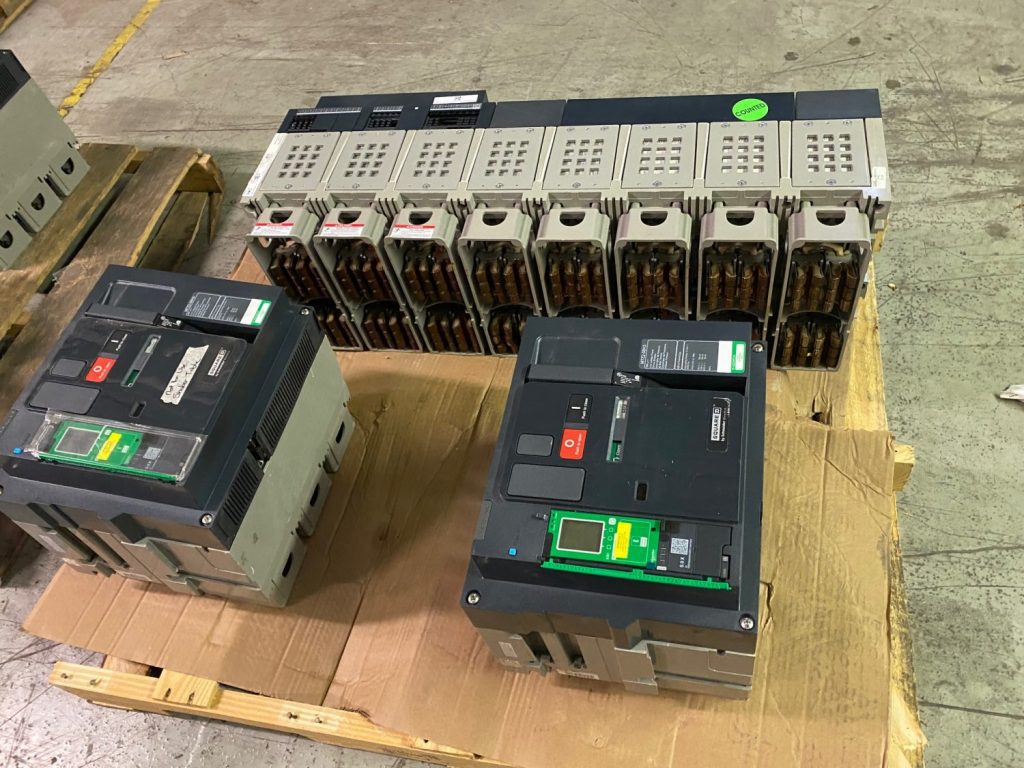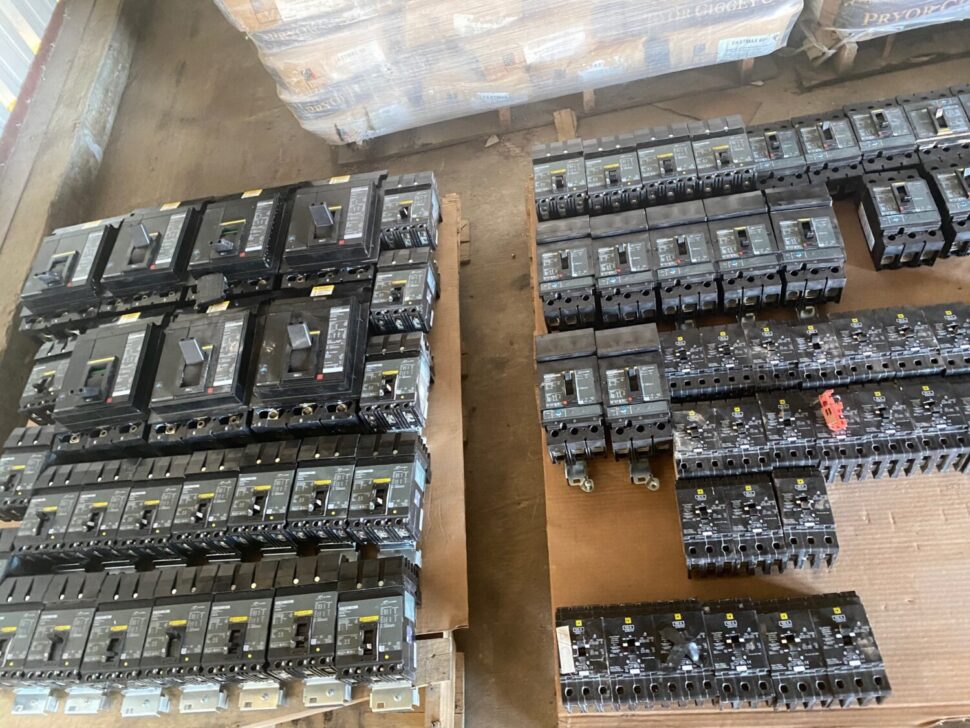Circuit Breaker Buyers Near Murrieta CA
Circuit Breaker Brands We Buy:
Schneider Electric
Siemens
ABB
Eaton
General Electric (GE)
Mitsubishi Electric
Rockwell Automation
Legrand
Fuji Electric
Toshiba
Square D (a brand of Schneider Electric)
Alstom
L&T Electrical and Automation
Havells
Hyundai Electric
CHINT Group
Honeywell
Hitachi
TE Connectivity
S&C Electric Company
NOARK Electric
Moeller Electric (now part of Eaton)
Tavrida Electric
Hager Group
Hyundai Heavy Industries
LS Electric
Meidensha Corporation
Powell Industries
Carling Technologies
Larsen & Toubro (L&T)
Sensata Technologies
Brush Electrical Machines (now part of CG Power and Industrial Solutions)
Maxwell Technologies (now part of Tesla)
Mersen
Larsen & Toubro (L&T) Electrical and Automation
Micron Industries Corporation
Terasaki Electric Co., Ltd.
Mitsubishi Electric Power Products
General Switch Company
ETA Electric Industry Co., Ltd.
Zinsco (now part of Schneider Electric)
Bussmann (now part of Eaton)
GE Grid Solutions
Airpax (now part of Sensata Technologies)
Camsco Electric Co., Ltd.
Alpha Technologies
Crompton Greaves (now part of CG Power and Industrial Solutions)
Kraus & Naimer
Joslyn Clark (now part of Danaher)
E-T-A Circuit Breakers
Types of Circuit Breakers We Buy:
Miniature Circuit Breakers (MCBs): Designed for residential and light commercial applications, MCBs are commonly used for branch circuit protection.
Molded Case Circuit Breakers (MCCBs): Suitable for higher current and voltage applications, MCCBs are often used in industrial settings to protect larger circuits.
Air Circuit Breakers (ACBs): Used for high-power distribution and industrial applications, ACBs are capable of interrupting larger currents and are often adjustable for different settings.
Oil Circuit Breakers: Historically used, these breakers contain oil as an arc quenching medium. They are less common today due to environmental concerns.
Vacuum Circuit Breakers: Utilizing a vacuum as the arc quenching medium, these breakers are often used in medium-voltage applications and are more environmentally friendly than oil circuit breakers.
Gas Circuit Breakers: These circuit breakers use sulfur hexafluoride (SF6) or other gases as the arc quenching medium. They are commonly used in high-voltage applications.
Ground Fault Circuit Interrupters (GFCIs): Primarily used in residential and commercial applications, GFCIs quickly interrupt power if they sense a ground fault, protecting against electrical shocks.
Arc Fault Circuit Interrupters (AFCIs): Designed to detect and respond to potentially dangerous arc-faults in residential electrical wiring that could lead to fires.
Residual Current Circuit Breakers (RCCBs): Provide protection against electrical faults, such as ground faults and leakages of current.
High-Voltage Circuit Breakers: Used in power transmission and distribution systems, these breakers can handle very high voltage levels.
Low-Voltage Circuit Breakers: Commonly used in residential, commercial, and industrial settings, these breakers are designed for lower voltage applications.
Hydraulic Magnetic Circuit Breakers: Use a hydraulic delay for overload protection and are often found in applications where temperature changes can affect electronic components.
Thermal-Magnetic Circuit Breakers: Combine thermal and magnetic protection for a more comprehensive approach to overload and short-circuit protection.
Electronic Trip Circuit Breakers: Use electronic sensors for more precise and adjustable protection settings.
Ground Fault Protection Circuit Breakers (GFP CB): Similar to GFCIs, these circuit breakers provide ground fault protection but are designed for specific applications, such as in industrial settings.
High-Speed Circuit Breakers: Engineered for rapid interruption of short circuits, these breakers are crucial in preventing damage to equipment.
Medium-Voltage Vacuum Circuit Breakers: Specifically designed for medium-voltage applications, these breakers utilize vacuum technology for arc interruption.
Medium-Voltage Oil Circuit Breakers: While less common than in the past, some medium-voltage applications still use oil circuit breakers.
Drawout Circuit Breakers: These breakers are designed to be easily removed or “drawn out” from their housing for maintenance or replacement without de-energizing the entire system.
Inverse Time Circuit Breakers: Respond to overcurrent conditions with a time delay inversely proportional to the magnitude of the current.
Time-Lag Circuit Breakers: Similar to inverse time breakers, these provide a time delay before tripping to accommodate temporary overloads.
Fast-Acting Circuit Breakers: Designed to quickly trip in response to overcurrent conditions, offering protection against short circuits.
Electronic Overcurrent Relays: Utilize electronic components for precise control over overcurrent protection.
Multi-Rated Circuit Breakers: Capable of handling different voltage and current ratings, providing flexibility in various applications.
Undervoltage Release Circuit Breakers (UVR CB): Trip when the voltage falls below a predetermined level, protecting equipment from undervoltage conditions.
Shunt Trip Circuit Breakers: Equipped with an additional electromagnetic coil that, when energized, trips the circuit breaker, often used for remote tripping.
Ring Main Unit (RMU) Circuit Breakers: Commonly used in medium-voltage distribution networks, providing switching and protection functions.
Electronic Earth Leakage Circuit Breakers: Combine the features of RCCBs with electronic sensing for improved ground fault protection.
Power Distribution Units (PDUs) with Circuit Breakers: Often used in data centers, these units integrate circuit breakers for individual outlets.
Dual Function AFCI/GFCI Circuit Breakers: Combine the features of AFCIs and GFCIs in a single device for comprehensive protection.
Photovoltaic Circuit Breakers: Designed for use in solar power systems, providing protection for photovoltaic arrays.
Circuit Breaker Enclosures: Provide additional protection for circuit breakers in outdoor or harsh environments.
Motor Circuit Protectors: Specifically designed to protect electric motors from overloads and short circuits.
Energy Limiting Circuit Breakers: Restrict the amount of energy delivered during a fault to reduce potential damage.



